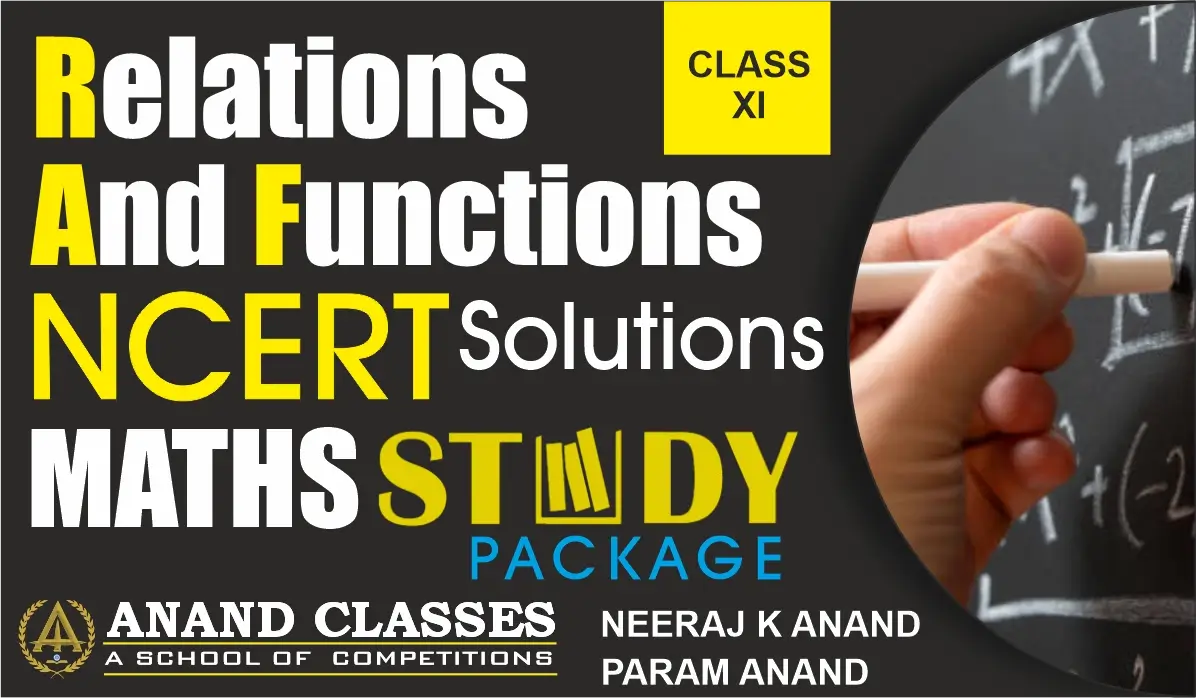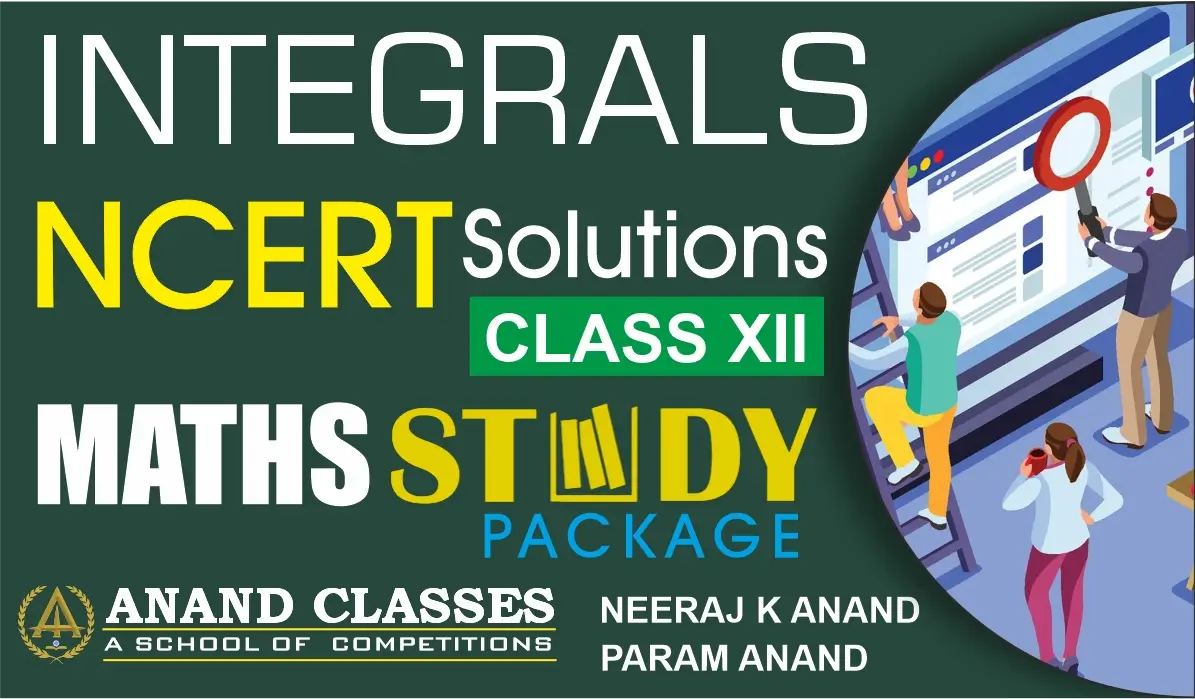Anand Classes brings you Relations and Functions NCERT Solutions Exercise 2.1 Class 11 Math Chapter-2 PDF Free Download (Set-1) with clear explanations and accurate answers prepared by expert faculty. These solutions help Class 11 students strengthen concepts of ordered pairs, domain, co-domain, and types of relations to score full marks in exams with confidence. Click the print button to download study material and notes.
NCERT Question 1:
If $ \left(\dfrac{x}{3} + 1, y – \dfrac{2}{3}\right) = \left(\dfrac{5}{3}, \dfrac{1}{3}\right), $ find the values of $x$ and $y$
Solution:
We know that if two ordered pairs are equal, then their corresponding elements are also equal.
So,
$$
\left(\frac{x}{3} + 1, y – \frac{2}{3}\right) = \left(\frac{5}{3}, \frac{1}{3}\right)
$$
means
$$
\frac{x}{3} + 1 = \frac{5}{3} \quad \text{and} \quad y – \frac{2}{3} = \frac{1}{3}
$$
Now, solving both equations step by step:
$$
\frac{x}{3} + 1 = \frac{5}{3}
$$
$$
\frac{x}{3} = \frac{5}{3} – 1
$$
$$
\frac{x}{3} = \frac{2}{3}
$$
$$
x = 2
$$
Similarly,
$$
y – \frac{2}{3} = \frac{1}{3}
$$
$$
y = \frac{1}{3} + \frac{2}{3}
$$
$$
y = \frac{3}{3} = 1
$$
✅ Therefore,
$$
x = 2 \quad \text{and} \quad y = 1
$$
This question from NCERT Class 11 Maths Chapter 2 — Relations and Functions helps students understand the equality of ordered pairs in functons. At Anand Classes, such problems are explained step by step so that students can clearly see how corresponding elements in ordered pairs are compared to find the correct values of (x) and (y). Regular practice of these types of equations at Anand Classes strengthens the foundation in algebra and coordinate geometry, ensuring better performance in NCERT board exams and JEE competitive mathematics tests.
NCERT Question 2:
If the set A has 3 elements and the set B = {3, 4, 5}, then find the number of elements in $ (A \times B)$.
Solution:
Given,
Number of elements in set A = 3
The elements of set B are 3, 4, 5.
So, number of elements in set B = 3.
Now,
The number of elements in the Cartesian product $( A \times B )$ is given by:
$$
n(A \times B) = n(A) \times n(B)
$$
Substituting the values,
$$
n(A \times B) = 3 \times 3
$$
$$
n(A \times B) = 9
$$
✅ Therefore, the number of elements in $( A \times B )$ is 9.
This question from NCERT Class 11 Maths Chapter 2 — Relations and Functions explains how to find the number of elements in the Cartesian product of two sets. At Anand Classes, students learn that if one set has (m) elements and another has (n) elements, then their product $( A \times B )$ will contain $( m \times n )$ ordered pairs. Understanding this concept helps in mastering relations and functions, an important topic in NCERT Maths and competitive JEE and NDA exams preparation.
NCERT Question 3:
If $G = \{7, 8\}$ and $H = \{5, 4, 2\}$, find $( G \times H )$ and $( H \times G )$.
Solution:
Given,
If $G = \{7, 8\}$ and $H = \{5, 4, 2\}$
The Cartesian product of two non-empty sets ( P ) and ( Q ) is the set of all ordered pairs of elements from ( P ) and ( Q ).
That is,
$$
P \times Q = {(p, q) \; |\; p \in P, q \in Q}
$$
So,
$$
G \times H = {(g, h) \; |\; g \in G, h \in H}
$$
Substituting the elements of ( G ) and ( H ):
$$
G \times H = \{(7, 5), (7, 4), (7, 2), (8, 5), (8, 4), (8, 2)\}
$$
Similarly,
$$
H \times G = \{(h, g) \; |\; h \in H, g \in G\}
$$
$$
H \times G = \{(5, 7), (5, 8), (4, 7), (4, 8), (2, 7), (2, 8)\}
$$
✅ Therefore,
$$
G \times H = \{(7, 5), (7, 4), (7, 2), (8, 5), (8, 4), (8, 2)\}
$$
and
$$
H \times G = \{(5, 7), (5, 8), (4, 7), (4, 8), (2, 7), (2, 8)\}
$$
This exercise from NCERT Class 11 Maths Chapter 2 — Relations and Functions illustrates the concept of Cartesian products and how the order of sets matters in forming ordered pairs. At Anand Classes, students are taught to carefully list all possible combinations while finding $( A times B )$ or $( B times A )$, helping them strengthen their understanding of relations and functions — an important concept in Class 11 Mathematics and competitive JEE and NDA exams preparation.
NCERT Question 4 :
State whether each of the following statements are true or false. If the statement is false, rewrite the given statement correctly.
(i) If $P = \{m, n\}$ and $Q = \{n, m\}$, then
$P \times Q = \{(m, n), (n, m)\}.$
(ii) If $A$ and $B$ are non-empty sets, then $A \times B$ is a non-empty set of ordered pairs $(x, y)$ such that $x \in A$ and $y \in B$.
(iii) If $A = \{1, 2\} $ and $B =\{3, 4\}$, then $A \times (B \cap \emptyset) = \emptyset.$
Solution:
(i)
If $P = \{m, n\}$ and $Q = \{n, m\}$, then
$P \times Q = \{(m, n), (n, m)\}.$
This statement is False.
Since $P = Q = \{m, n\}$, the correct Cartesian product is:
$$P \times Q = \{(m, m), (m, n), (n, m), (n, n)\}.$$
(ii)
If $A$ and $B$ are non-empty sets, then $A \times B$ is a non-empty set of ordered pairs $(x, y)$ such that $x \in A$ and $y \in B$.
This statement is True.
(iii)
If $A = \{1, 2\} $ and $B =\{3, 4\}$, then $A \times (B \cap \emptyset) = \emptyset.$
Solution:
This statement is True, since $B \cap \emptyset = \emptyset$ and
$$A \times \emptyset = \emptyset.$$
Perfect to print and study — helpful for CBSE Class 11 Maths Relations and Functions chapter. Download notes by Anand Classes for smart exam preparation.
NCERT Question 5 :
If $A = \{-1, 1\}$, find $A \times A \times A$.
Solution :
$A \times A \times A$ for a non-empty set $A$ is given by
$$A \times A \times A = \{(a, b, c) : a, b, c \in A\},$$
where $(a, b, c)$ is called an ordered triplet.
Here, $A = \{-1, 1\}$
So,
$$A \times A \times A = \{(-1, -1, -1), (-1, -1, 1), (-1, 1, -1), (-1, 1, 1), \\[1em] (1, -1, -1), (1, -1, 1), (1, 1, -1), (1, 1, 1)\}.$$
Prepare smarter with Class 11 Relations and Functions notes by Anand Classes — high-quality solutions for CBSE and competitive exams.


